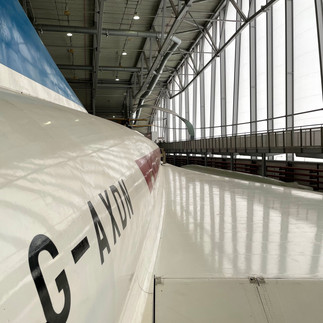Imperial War Museum Duxford
A new day brings a new adventure and now we were headed further East, and the scenery was increasingly different from what we Welshies are used to. The lush green rolling hills were replaced by a flatter landscape with shorter and more sparse hedges. We were surrounded by vast horizons in almost every direction. "It's just like France!" the boys said from the backseat. However, we were not going to France this year. Instead, we continued our good old staycation and continued our exploration of new places closer to home. We had checked off seeing crocodiles in Oxfordshire and experiencing technological developments in Bletchley Park in Milton Keynes. Today we were headed to the Imperial War Museum Duxford Airfields to learn about aviation history.
On our arrival at Duxford, I thought to ask how long to expect the visit to last. We were hoping to meet family later that afternoon. I had seen the on museum's webpage to allow at least half a day but I had thought to myself how long can it take to check out a few aeroplanes? The lovely young man at the reception desk told me it would take at least 5-6 hours as Duxford Airfield is the biggest aviation museum in Europe. That told me! I should have done my pre-visit research better. Six hours later and we had no idea where and how time had flown. I soon learned that there was indeed a lot to see and learn about aircraft and aviation history and it is much more interesting than I had given it credit for. Let me correct myself regarding the statement I made about a few aeroplanes … make that hundreds of aircraft along with many other objects like military vehicles including tanks, missiles, and small naval vessels as well as books, documents, films, photographs, and uniforms with the addition of human stories and experiences. The vast collection is cleverly arranged around various themes and wartime stories, history spread over the museum's immense site. We walked over 7 km while there, that’s your 10,000 plus steps for the day! IWM Duxford's history spans from the early days of the First World War when Duxford airfield was first taken into use and was one of the first Royal Airforce stations, so there is a lot here for the museum to show and tell visitors.
One feels quite small in large hangars filled with aircraft covering almost every inch of floor and ceiling; big and small, old and even older aircraft. We lost time walking among them, under them, through them, seeing how people travelled and worked up in the skies in the past all while learning all about each plane and its staff's history. I wasn’t quite prepared for how close up we would get to the aircraft, making their stories such as D-Day and the Battle of Britain all the more tangible. Typically, we encounter these stories through books, documentaries and films.
In the Aerodrome hangar, we came face to face with the Avro Lancaster bomber, used in the Dambusters raid we spoke of in our blog about Derbyshire when Julie and Wayne visited Ladybower Reservoir. We stepped on board a Concord and a BOAC airliner which was a trip back to the past. An old helicopter that looked like nothing we’d ever seen hung from the ceiling among all the other different aircraft in there, some reminding us of their gloomy reality with bombs military trucks and cars lined along them. We found the exhibit showcasing the history of the British Airborne Assault interesting. It was fascinating to see the progression of the equipment worn by the brave people who jumped out of planes during the early days of airborne assaults, and how it has developed to more present day, such as in Afghanistan.
While in the Aerodrome hangar, we could hear planes zooming by. At first, I thought the sound of them came from speakers for effect but they were actual planes regularly taking off, flying over the airfields, touching the ground only to whip up again. This is what they do all day long and some take aboard paying passengers, we didn’t dare check the price tag for that one. As luck would have it, Spitfire was whipping over the airfield when we left the Aerodrome, and over again, it landed and took off again. Repeat. One could easily imagine the raw roars of many of them would make, and the hustle and bustle of pilots and crews busy getting planes ready to take off.

After gazing after the Spitfire, we headed to the American Air Museum which is part of IWM Duxford and there you will be acquainted with various American aircraft from World War II to the more contemporary remotely piloted Predator. Three aircraft stood out for us. The Boeing B52D Stratofortress, the clue is in the name. It is huge and made the other aircraft look tiny! The Lockheed SR-71 Blackbird looks pretty menacing with its matt black and sleek lines giving it the look of a stealthy underwater predator. I must have been dumbstruck by the sight of them because I realised afterwards I hadn't snapped one single photograph of either of them. It didn’t come as much surprise but the boys were most excited about “The Top Gun plane”. Among the aircraft were poster boards and along the concrete walls were engravings that told stories, thoughts, and feelings from people who worked with these planes and those affected by global conflicts.

Each hangar in Duxford Airfields has a unique role to play, some of which date back to the historic Battle of Britain. These hangars are integral in recounting aviation tales, such as the Battle of Britain, the Air and Sea Exhibition, and Conservation in Action. We liked the calm atmosphere in the conservation hanger where visitors can witness dedicated conservationists as they meticulously preserve, clean, and reconstruct vintage aircraft.

Our visit to The Land Warfare Hall was a sombre experience. It’s a collection of artillery, armoured and other military vehicles all set as if they are in a war zone and conflict.
I highly recommend a day in IWM Duxford and will leave you with my 13-year-old son's thoughts on it.
“This was my favourite trip so far. I found it very cool how you could go into some of the planes. I also liked how they set it up and had some planes floating from the roof. I also liked that there were some planes that they flew. It was cool that you could see them restore some of the planes and have them checked. The only downside to this was that it was very spread out and took a long time to see everything.”
Lísa x














































































Comments